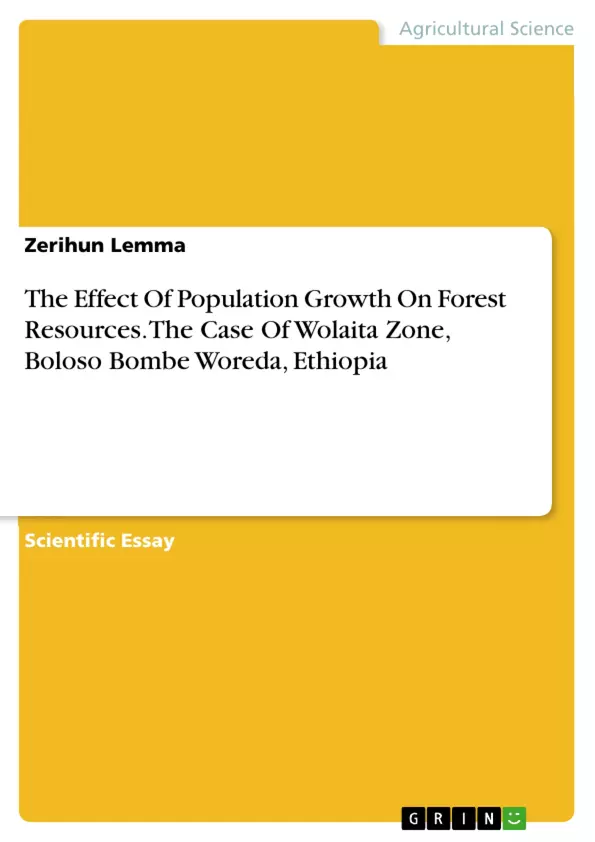This study is aimed to assess the effects of population growth on forest resources exhibiting in Zaba village in Boloso Bombe Woreda and to suggest remedial solutions before the environment is getting worse and its serious outcome.
Ethiopia is one of the countries where forest resources degradation exhibits primarily due to population explosion. The forest policy is also not said to be effective in forest policy regards. At present, it is facing a serious ecological problem triggered mainly by the fast growth of population which led to destructive nature of land resource uses involving deforestation even without leaving time space for regeneration of natural forests. The situation exposes the land to serious land degradation altering local environment and microclimate. To change this situation urgent natural resource management primarily forest management strategies intervention is required.
Table of Contents
- 1. INTRODUCTION
- 1.1 Background
- 1.2 Statement of the problem
- 1.3 OBJECTIVE
- 1.3.1 General Objective
- 1.3.2 Specific Objective
- 2. LITERATURE REVIEW
- 3. STUDY AREA DESCRIPTION
- 3.1 Location
- 3.2 Topography
- 3.3 Vegetation
- 3.4 population
- 3.5 Climate
- 3.6 Land-use land cover Situation
- 3.7 Wild Life
- 3.8 Livelihood
- 3.9 Economic Activity
- 4. METHODOLOGY
- 4.1 Data Collection Techniques
- 5. RESULTS AND DISCUSSION
- 5.1 Socio economic features of the study area
- 5.1.1 Household income
- 5.2 Forest status and forest management
- 5.3 Land Size of the households
- 5.4 Energy sources of the households
- 5.5 Family Size of the households
- 5.6 Family Planning
- 5.1 Socio economic features of the study area
- 6. CONCLUSION AND RECOMMENDATIONS
- 6.1 Conclusion
- 6.2.Recommendations
Objectives and Key Themes
This research study aims to assess the impact of population growth on forest resources in the Wolaita Zone, Boloso Bombe Woreda, specifically focusing on the Wotagisho Natural Forest. The study seeks to understand the complex relationship between population dynamics and environmental degradation, with particular emphasis on the consequences of population pressure on forest resources. The research explores potential solutions and management strategies to mitigate the negative effects of population growth on the environment.
- Population Growth and its Impact on Forest Resources
- Deforestation and Environmental Degradation
- Forest Management Strategies and Solutions
- Socioeconomic Factors Influencing Forest Resource Use
- Environmental Sustainability and Resource Management
Chapter Summaries
The study begins by providing a detailed introduction to the intricate relationship between population growth and environmental degradation, specifically focusing on the impact of population pressure on forest resources. The introduction highlights the critical role of forests in maintaining ecological balance and economic sustainability. Chapter 2 delves into a comprehensive review of existing literature on the subject, exploring various perspectives on population dynamics, deforestation, and sustainable forest management practices. Chapter 3 presents a detailed description of the study area, providing insights into its geographical location, topography, vegetation, population characteristics, climate, land-use patterns, wildlife, livelihood strategies, and economic activities. Chapter 4 outlines the methodology employed in the study, including data collection techniques and analysis methods used to gather and interpret information about the relationship between population growth and forest resources. Chapter 5 presents the findings of the research, analyzing the socioeconomic features of the study area, the status of forest resources, and the impact of population growth on forest management practices. This chapter also explores the relationship between household income, land size, energy sources, family size, and family planning practices within the study area.
Keywords
The key focus areas of this research include population growth, deforestation, forest resource management, environmental sustainability, ecological balance, socioeconomic factors, and the impact of population pressure on the environment. The study examines the effects of population growth on forest resources, specifically in the context of the Wotagisho Natural Forest in the Wolaita Zone, Boloso Bombe Woreda. The research aims to understand the underlying factors driving deforestation and to identify sustainable forest management strategies that can mitigate the negative consequences of population growth. The study incorporates a detailed analysis of the socioeconomic characteristics of the study area, including household income, land size, energy sources, and family planning practices.
- Citar trabajo
- Zerihun Lemma (Autor), 2020, The Effect Of Population Growth On Forest Resources. The Case Of Wolaita Zone, Boloso Bombe Woreda, Ethiopia, Múnich, GRIN Verlag, https://www.grin.com/document/978867



